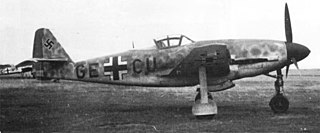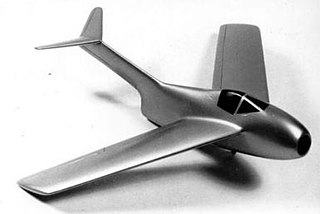Related Research Articles

The Focke-Wulf Ta 154 Moskito was a fast twin-engined night fighter aircraft designed by the German aeronautical engineer Kurt Tank and produced by the aircraft manufacturer Focke-Wulf. It was unofficially named Moskito due to its similarities with the de Havilland Mosquito that were already with the Royal Air Force (RAF).

The Focke-Wulf Fw 190, nicknamed Würger (Shrike) is a German single-seat, single-engine fighter aircraft designed by Kurt Tank at Focke-Wulf in the late 1930s and widely used during World War II. Along with its well-known counterpart, the Messerschmitt Bf 109, the Fw 190 became the backbone of the Jagdwaffe of the Luftwaffe. The twin-row BMW 801 radial engine that powered most operational versions enabled the Fw 190 to lift larger loads than the Bf 109, allowing its use as a day fighter, fighter-bomber, ground-attack aircraft and to a lesser degree, night fighter.

The Focke-Wulf Fw 187 Falke ("Falcon") was a German aircraft designed in 1935. It was conceived by Kurt Tank as a twin-engine, high-performance fighter, but the Luftwaffe saw no role for the design, perceiving it as intermediate between the Messerschmitt Bf 109 and Bf 110. Later prototypes were adapted to two-seats to compete with the Bf 110 in the heavy fighter (Zerstörer) role, but only nine aircraft were built in total.

The Messerschmitt Me 328 was a prototype pulsejet-powered fighter aircraft designed and produced by the German aircraft manufacturer Messerschmitt AG.

The Henschel Hs 132 was a jet-powered dive bomber and interceptor aircraft designed and produced by the German aircraft manufacturer Henschel Flugzeugwerke AG. It was developed during the latter portion of the Second World War with the intention of being adopted by the Luftwaffe, but this did not come to fruition.

The Messerschmitt Me 309 was a prototype German fighter, designed in the early years of World War II to replace the Messerschmitt Bf 109. Although it had many advanced features, the Me 309's performance left much to be desired and it had so many problems that the project was cancelled with only four prototypes built. The Me 309 was one of two failed Messerschmitt projects intended to replace the Bf 109, the other being the 1943 Me 209 project.

The Focke-Wulf Ta 183 Huckebein was a design for a jet-powered fighter aircraft intended as the successor to the Messerschmitt Me 262 and other day fighters in Luftwaffe service during World War II. It had been developed only to the extent of wind tunnel models when the war ended, but the basic design was further developed postwar in Argentina as the FMA IAe 33 Pulqui II. The name Huckebein is a reference to a trouble-making raven from an illustrated story in 1867 by Wilhelm Busch.
The Focke-Wulf Ta 153 (GH+KV) was a prototype German fighter aircraft built during World War II. It was a development of the Fw 190C, a Fw 190A with a DB 603A engine.
The Focke-Wulf Ta 400 was a large six-engined heavy bomber design developed in Nazi Germany in 1943 by Focke-Wulf as a serious contender for the Amerikabomber project. One of the first aircraft to be developed from components from multiple countries, it was also one of the most advanced Focke-Wulf designs of World War II, though it never progressed beyond a wind tunnel model.
The Focke-Wulf Project II was a design study for a single-seat jet fighter, carried out in Germany during World War II.
The Focke-Wulf Project III was a design study for a jet fighter, carried out in Germany in June 1943. It aimed to reduce the risk of foreign object damage to the engine that had been foreseen for the Project II, by relocating the engine from beneath the fuselage to a position atop the fuselage, with the jet intakes at the fuselage sides. In most other respects, it was similar to Project II, but as well as the engine relocation, Project II's conventional tail was replaced with twin tails on the ends of the horizontal stabiliser, in order to provide a path for the jet exhaust.

The Focke-Wulf Flitzer was a jet fighter under development in Germany at the end of World War II.
The Focke-Wulf Peterle was a design study for a turboprop-powered fighter-bomber, undertaken in Germany during World War II.

The Blohm & Voss P 194 was a German design for a mixed-power Stuka or ground-attack aircraft and tactical bomber, during World War II.

The Heinkel He P.1079 was a projected German V-tail all weather jet fighter designed by Heinkel Flugzeugwerke in the closing stages of World War II. The aircraft was only a design; it was not produced.
The Messerschmitt P.1092 was a series of Messerschmitt experimental aircraft for the Luftwaffe during the Second World War. Several designs for single- and twin-engined aircraft were drafted under the same designation.

The Messerschmitt P.1099 was a two-seat prototype jet plane designed by Messerschmitt for the Luftwaffe before the end of the Second World War.

The Focke-Wulf Volksjäger, was a German emergency fighter project for the Luftwaffe. It was designed by Focke-Wulf towards the end of World War II as part of the defense effort against the devastating Allied bombing raids.

The Messerschmitt Me 262 was a German World War II fighter aircraft built by Messerschmitt in the later stages of the war, and under license by Avia post-war.
References
- Lens, K.; H. J. Nowarra (1964). Die Deutschen Flugzeuge. Munich: J F Lehmans Verlag.
- Masters, David (1982). German Jet Genesis. London: Jane's Publishing.
- Myhra, David (1998). Secret Aircraft Designs of the Third Reich. Atglen: Schiffer. p. 142.
- Nowarra, Heinz (1983). Die deutsche Luftrüstung 1933-1945. Bonn: Bernard and Graefe. pp. Teil 2, p.114.
- Schick, Walter; Ingolf Meyer (1997). Luftwaffe Secret Projects: Fighters 1939-1945 . Hinckley: Midland Publishing. pp. 52.
- Smith, J. R. (1973). Focke-Wulf: An Aircraft Album. London: Ian Allan.
- Smith, J. R.; A. Kay (1972). German Aircraft of the Second World War. London: Putnam.
- Wagner, Wolfgang (1980). Kurt Tank: Konstruckteur und Test Pilot bei Focke-Wulf. Munich: Bernard and Graefe.